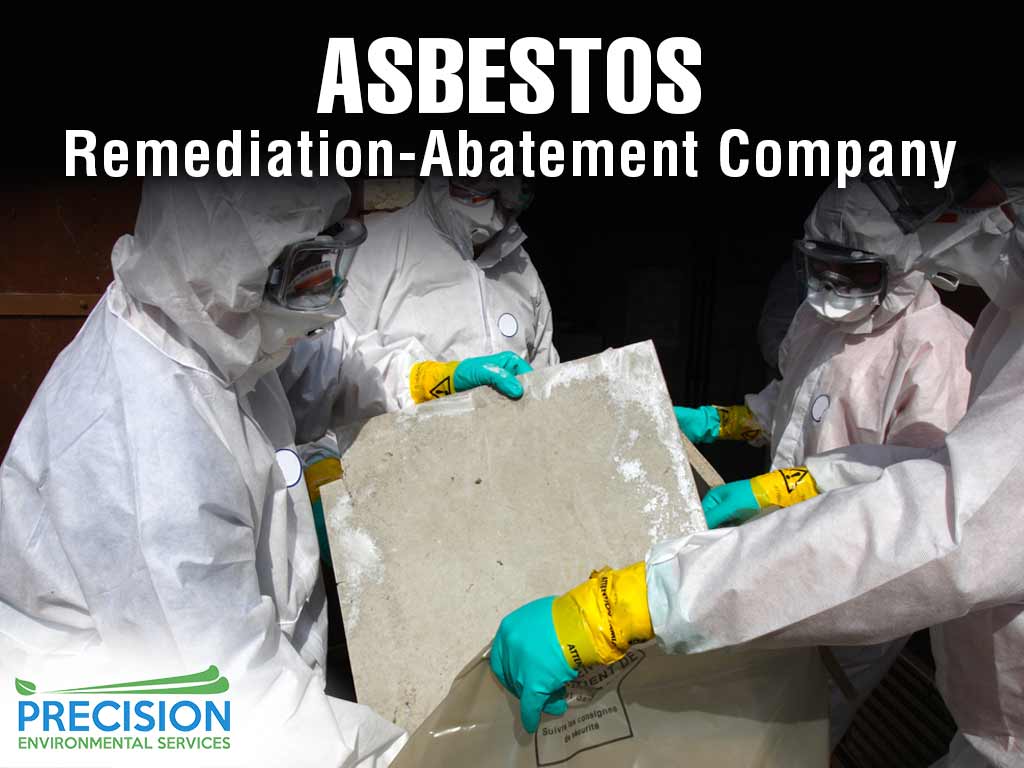ASBESTOS REMEDIATION or ABATEMENT COMPANY
For decades, asbestos was thought to be a super material in the construction world due to its strength and flame-resistant properties. However, as the long-term effects of asbestos have been studied, experts have found that the mineral poses a threat to human health in several ways, which is why it is so important to be able to identify materials that may contain asbestos and get rid of them.
WHAT IS ASBESTOS?
Throughout the 20th Century, builders found asbestos to be a useful material in plastics, cement, paper, and even in some clothing. Some of the common products that could contain asbestos in your home, or property, including roof shingles and siding, textured ceilings, drywall and cement, plumbing fixtures, and even vinyl floor tiles. At the time it was widely used, because asbestos is a naturally-occurring mineral, it was not known how dangerous it could be.
Along with certain cancers, exposure to asbestos can cause many health-related issues, including:
- Mesothelioma is a type of cancer that affects the thin layer of tissue that covers the internal organs, most commonly affecting the lungs and chest wall.
- Asbestosis happens when asbestos causes scarring of the lung tissue and can lead to shortness of breath and Mesothelioma.
- Pleural effusions cause a build-up of fluid between layers of the outside of the lungs.
- Pleural plaques can build-up in the outside layers of the lungs, and put patients at risk for certain cancers.
- Pleuritis is the inflammation of the membranes lining the lungs and can cause sharp pains when breathing.
- COPD, or Chronic obstructive pulmonary disease, causes inflammation that can obstruct airflow to the lungs.
It was not until 1986 that the Asbestos Hazard Emergency Response Act was established, which required local agencies to survey buildings for asbestos-containing materials, create asbestos management plans, and build response procedures to prevent and reduce asbestos hazards.
WHAT IS ASBESTOS ABATEMENT?
When it comes to asbestos, the worst effects typically take place with a person is exposed to a large amount of the mineral, or when a person is exposed to it regularly over a long period. Asbestos becomes dangerous when it is released into the air when the materials in which it was used are disturbed. The fibers are easily inhaled, and once they begin to accumulate in the body there is not currently a way to reverse the damage. This is why it is so important to have a professional asbestos survey performed on any damaged building materials or materials that could be disturbed during a renovation project.
If asbestos is found in your home or property, remediation, or asbestos removal, will need to take place. Common solutions for getting rid of asbestos are abatement and remediation. Sometimes used synonymously, abatement can be a part of remediation, but there are some differences in the two processes.
Abatement versus Remediation?
Abatement: During the abatement, the asbestos-containing material is either completely removed or encapsulated so that it no longer poses a threat to human health.
Remediation: Taking it a step further, remediation addresses the underlying issue of asbestos contamination so that you can prevent it from happening in the future.
While homeowners are not required to hire a licensed asbestos abatement or remediation company, it is strongly recommended due to all of the regulations that must be met for the removal process. So, before you choose a company to handle your asbestos problem, ensure their qualifications meet your needs.
Asbestos removal work falls into three main categories:
Class 1 Work: This type of asbestos removal work is potentially one of the most hazardous, as it deals with materials that prevent the loss or gain of heat. That includes thermal insulation, pipes, ducts, tanks, and any sprayed-on or troweled-on surface.
Class 2 Work: Asbestos removal in the second class of related work includes non-thermal materials that potentially contain asbestos, including flooring and roofing materials, as well as ceiling tiles, siding, and shingles.
Class 3 Work: This type of work involves cleaning up asbestos-containing waste and debris, typically caused by some kind of construction or repair activities. That includes dusting, vacuuming, and mopping the area where any fibers could accumulate.
After the abatement or remediation is performed, an air test should be performed before anyone can enter the area without proper protective gear. Successful remediation or abatement should return a test with less than .01 fibers per cc.
HOW MUCH DOES ASBESTOS REMOVAL COST?
Now that you have a better understanding of what asbestos is and how it can pose a serious health threat, as well as the importance of having it removed from your home or other property, you are better equipped to understand what you need to take care of the problem. What you might be wondering at this point is, “How much will this cost me?” The truth is it can be a costly situation.
Because of the regulations that guide the asbestos remediation process and the protective measures to ensure safety, getting rid of the mineral can be expensive.
Some of the costs a homeowner might incur include:
- Initial Home Inspection: $400 – 600
- Sample Analysis: Up to $75
- Complete Asbestos Removal from an Average-Sized House: $20,000 – 30,000
For commercial buildings, the costs can be even higher. In some cases, businesses may spend millions of dollars to get rid of asbestos.
HIRING AN ASBESTOS ABATEMENT COMPANY
Enlisting a professional to manage the removal of asbestos, and not attempting to do it yourself, is a smart decision that will keep you safe. Trained professionals will be able to properly test for asbestos, follow all safety guidelines, and keep you safe from possible exposure.
Start by doing your research
Ask companies you might potentially hire for references and about their processes for removing asbestos from a property. Make sure they are properly trained to handle the problem, and, most importantly, that you are comfortable with the company.






